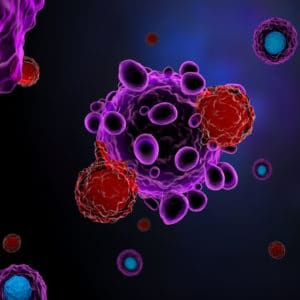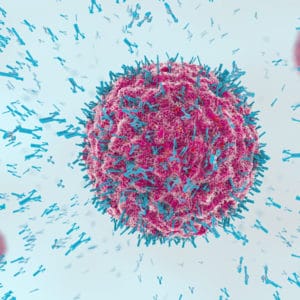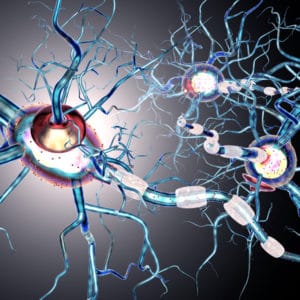Therapeutic Areas in Drug Discovery & Clinical Research
Immuno-Oncology (IO)/Cancer
 Our immune system can be conceptualized as a balance-scale in providing appropriate responses against invading pathogens and tumor cells on the one hand, while limiting collateral damage to healthy cells, known as “autoimmunity”, on the other. When the aggressive response is inappropriately met with regulatory mechanisms, autoimmunity may occur, resulting in serious disorders such as lupus, rheumatoid arthritis and type 1 diabetes, and where the balance favors immunosuppression, cancers can thrive.
Our immune system can be conceptualized as a balance-scale in providing appropriate responses against invading pathogens and tumor cells on the one hand, while limiting collateral damage to healthy cells, known as “autoimmunity”, on the other. When the aggressive response is inappropriately met with regulatory mechanisms, autoimmunity may occur, resulting in serious disorders such as lupus, rheumatoid arthritis and type 1 diabetes, and where the balance favors immunosuppression, cancers can thrive.
Immuno-oncology (IO) leverages the body’s own immune system to fight cancer and is revolutionizing the way we think about medicine because it is enabling long-term remission or in some cases “cures” to cancer patients. Common IO approaches involve antibody modulation of T-cells by various mechanisms, for example targeting T-cell checkpoints such as CTLA-4, PD-1, and PD-L1, redirecting T-cells via bispecifics antibodies or replenishing the immune system with “super-charged” T-cells, known as chimeric antigen receptor T-cellular (CAR-T) therapies. The clinical portfolio of antibodies in this space is diverse in format, engineering, and target, and requires deep knowledge of the mechanism of action (MOA) to ensure its safety and efficacy.
Carterra’s HT-SPR platforms provide a highly parallel way of screening hundreds of antibody binding interactions at once in terms of their binding kinetics, affinity, and epitope specificity. These binding properties underpin an understanding of antibody’s MOA and as such, are used as metrics to triage an antibody library to leads.
Infectious Diseases
 Several companies have sponsored the use of therapeutic antibody cocktails to provide medicines to individuals that have been infected with deadly viruses such as COVID-19, HIV, Ebola, yellow fever, Staph A, and the flu. In jawed vertebrates, antibodies have evolved in nature to fulfill the role of eliminating invading pathogens by binding to them and neutralizing their activity. Since antibodies naturally often achieve high affinity and exquisite specificity, they are appealing to use in a therapeutic setting to fight infectious diseases.
Several companies have sponsored the use of therapeutic antibody cocktails to provide medicines to individuals that have been infected with deadly viruses such as COVID-19, HIV, Ebola, yellow fever, Staph A, and the flu. In jawed vertebrates, antibodies have evolved in nature to fulfill the role of eliminating invading pathogens by binding to them and neutralizing their activity. Since antibodies naturally often achieve high affinity and exquisite specificity, they are appealing to use in a therapeutic setting to fight infectious diseases.
Therapeutic cocktails comprise a collection of antibodies targeting several distinct epitopes to collectively achieve a broad neutralization of the virulence factor. Defeating an ever-mutating virus poses challenges in designing an effective medicine but targeting multiple epitopes at once can offset biological redundancy – when one pathway fails, another often compensates.
Carterra’s HT-SPR platforms facilitate epitope characterization on hundreds of antibodies in parallel, allowing you to quickly understand the epitope coverage of your antibody library and focus resources on studying the epitope clusters with the most biologically-relevant function. When epitope binning studies are performed on a large panel of antibodies, the competition picture gains resolution and nuance, allowing a deep appreciation of the epitope diversity contained in the antibody library. Developing a potently neutralizing therapeutic antibody cocktail relies on the proper selection of antibodies with complementary epitopes. Carterra’s HT-SPR platforms accelerate the epitope characterization of an antibody library, such as one that is recovered by B-cell cloning of an Ebola survivor, to understand the immune response and guide the discovery of therapeutic antibody cocktails.
- Application Note: Discovery of Therapeutic Antibody Cocktails
- Application Note: Multi-Parameter Epitope-Centric Data Used to Elucidate Mechanisms of Action of Antibodies
- Publication: Wec et al, PNAS 2020, Longitudinal dynamics of the human B cell response to the yellow fever 17D vaccine
- Publication: Cairnes et al, J Virol 2019, Surface plasmon resonance (SPR) reveals direct binding of HSV glycoproteins gH/gL to gD and locates a gH/gL binding site on gD.
- Publication: Awasthi et al, Vaccine 2019, Antibody responses to crucial functional epitopes as a novel approach to assess immunogenicity of vaccine adjuvants.
- Publication: Hook et al, PLoS Pathog 2018, Vaccine-induced antibodies to herpes simplex virus glycoprotein D epitopes involved in virus entry and cell-to-cell spread correlate with protection against genital disease in guinea pigs.
- Publication: Yeung et al, Nature Commun 2016, Germline-encoded neutralization of a Staphylococcus aureus virulence factor by the human antibody repertoire
- Publication: Chukwuma et al, PLoS One 2018, Increased breadth of HIV-1 neutralization achieved by diverse antibody clones each with limited neutralization breadth
Auto-Immunity
 Autoimmune disease encompasses a range of disorders with the hallmark of an over-active immune system that launches a misdirected attack of auto-antibodies or inflammatory responses towards healthy cells. Some autoimmune diseases damage a specific organ, such as the pancreas in type 1 diabetes, the gastrointestinal tract in Crohn’s disease, or the skin in psoriasis, whereas others cause collateral damage to the entire body, such as lupus, multiple sclerosis and rheumatoid arthritis.
Autoimmune disease encompasses a range of disorders with the hallmark of an over-active immune system that launches a misdirected attack of auto-antibodies or inflammatory responses towards healthy cells. Some autoimmune diseases damage a specific organ, such as the pancreas in type 1 diabetes, the gastrointestinal tract in Crohn’s disease, or the skin in psoriasis, whereas others cause collateral damage to the entire body, such as lupus, multiple sclerosis and rheumatoid arthritis.
Therapeutic antibodies have proved highly successful in treating a variety of autoimmune diseases, as demonstrated by Humira (adalimumab), one of the biggest blockbuster drugs of all time. Like several other anti-inflammatory antibodies on the market, Humira targets and blocks tumor necrosis factor alpha (TNF-alpha), which relieves the pain and inflammation associated with some autoimmune diseases. Discovering “the next Humira” requires deep knowledge of biology to understand how to target other pathways relevant to autoimmune disease beyond TNF-alpha, such as T- and B-cell viability or activation, IL-1, IL-6, IL-17, and others. Understanding a drug’s mechanism of action (MOA) underpins the clinical success of any drug program.
Carterra’s HT-SPR instruments are high throughput analytical platforms that accelerate the screening and detailed characterization of large antibody libraries in terms of their binding kinetics, affinity and epitope specificity to provide crucial information about antibody binding properties that are used to assess and converge upon the most promising clinical candidates.
Pain
 Pain is caused by a complex interplay of physiological and psychological factors and managing pain is a clinical and economic burden on society. It is estimated that chronic pain affects 100 million adults in the USA, more than heart disease, cancer and diabetes combined. While opioids are one of the most widely prescribed painkillers for chronic pain, opioid abuse, addiction, and overdose pose serious public health concerns in the USA. Opioids are small molecule drugs that easily penetrate the blood-brain-barrier (BBB), where they alter neurobiochemical pathways in destructive ways, causing dependence and lethal addiction.
Pain is caused by a complex interplay of physiological and psychological factors and managing pain is a clinical and economic burden on society. It is estimated that chronic pain affects 100 million adults in the USA, more than heart disease, cancer and diabetes combined. While opioids are one of the most widely prescribed painkillers for chronic pain, opioid abuse, addiction, and overdose pose serious public health concerns in the USA. Opioids are small molecule drugs that easily penetrate the blood-brain-barrier (BBB), where they alter neurobiochemical pathways in destructive ways, causing dependence and lethal addiction.
Monoclonal antibodies are providing attractive alternatives to traditional small molecule therapies for treating chronic pain based on their high affinity and exquisite specificity that can minimize the unwanted off-target binding and adverse side-effects that seriously limit small molecule approaches. Due to their hydrophilicity and large molecular size, antibodies barely cross the BBB, so do not cause the lethal addictions of small molecule drugs. While the large size of antibodies limit their bioavailability via oral administration, necessitating injection via intravenous, intramuscular, or subcutaneous routes, this inconvenience to patients is somewhat offset by the naturally long serum exposure of antibodies, allowing for less frequent dosing, with some therapeutic antibodies requiring only a single injection per three months. From a practical perspective though, the high cost of developing and manufacturing therapeutic antibodies remains a major hurdle.
Therapeutic antibodies under clinical investigation and on the market aimed at treating chronic pain target a variety of molecules associated with pain pathways, including calcitonin gene-related peptide (CGRP), ion channels, nerve growth factor (NGF), tumor necrosis factor-alpha (TNF-alpha), and epidermal growth factor receptor (EGFR). Understanding how we can explore different mechanisms for treating pain is essential to bringing new medicines to market. Currently it takes about 12 years to progress a therapeutic antibody from bench to market, and antibodies for treating chronic pain are scrutinized in long and rigorous clinical trials.
Carterra’s HT-SPR platforms are high throughput screening and characterization tools for measuring antibody binding interactions, enabling the analysis of hundreds of interactions at once. By delivering high quality data quickly in the assessment of key binding parameters, such as kinetics, affinity, and epitope specificity, it can speed up research and ultimately help to converge upon clinically-ready leads faster.
Heart Disease
 Heart disease is the leading cause of death in the United States despite the availability of effective lipid-lowering drugs known as statins, such as Pfizer’s atorvastatin (Lipitor), which is the biggest blockbuster drug of all time. While lipid metabolism disorders are well-accepted as being associated with heart disease, not all patients respond to statins or can tolerate them, creating a need for supplemental and alternative therapies. Monoclonal antibodies that block the binding interaction of proprotein convertase subtilisin/kexin type 9 (PCSK9) enzyme to its receptor, so-called “PCSK9 inhibitors”, are providing a new era of lipid-lowering therapy, namely Praluent (alirocumab) by Sanofi/Regeneron and Repatha (evolocumab) by Amgen, which were approved for market use in 2015.
Heart disease is the leading cause of death in the United States despite the availability of effective lipid-lowering drugs known as statins, such as Pfizer’s atorvastatin (Lipitor), which is the biggest blockbuster drug of all time. While lipid metabolism disorders are well-accepted as being associated with heart disease, not all patients respond to statins or can tolerate them, creating a need for supplemental and alternative therapies. Monoclonal antibodies that block the binding interaction of proprotein convertase subtilisin/kexin type 9 (PCSK9) enzyme to its receptor, so-called “PCSK9 inhibitors”, are providing a new era of lipid-lowering therapy, namely Praluent (alirocumab) by Sanofi/Regeneron and Repatha (evolocumab) by Amgen, which were approved for market use in 2015.
When developing a new biotherapeutic, understanding the binding interactions that underpin its mechanism of action (MOA) are key to its success in the clinic. Carterra’s HT-SPR platforms are high throughput tools that enable interaction analysis measurements to be performed on hundreds of antibodies at once, allowing researchers to characterize the binding properties of antibody libraries quickly. The ability to generate kinetic, affinity and epitope specificity information at scale accelerates the library-to-lead triage, enabling the prioritization of resources to those antibodies with the most desirable binding properties.
COVID-19
 COVID-19 has highlighted the severe time constraints a pandemic of this nature places on traditional means of therapeutic discovery. The rapid spread of this virus has required an approach to therapeutic and vaccine development measured in weeks rather than years. Further complicating efforts is the uniqueness of therapeutically relevant epitopes SARS-CoV-2 presents, which dictate that existing medicines may be limited in their effectiveness. Novel mutations in the SARS-CoV-2 spike protein have increased affinity towards the ACE-2 receptor and are attributed to increases in morbidity and mortality rates compared with SARS-CoV-1, making identification of viable medicines even more critical. Therefore, combating rapidly emerging infectious diseases necessitates both increased throughput but also a detailed understanding of mechanism of action (MOA) at a much earlier stage of therapeutic development than has been done historically.
COVID-19 has highlighted the severe time constraints a pandemic of this nature places on traditional means of therapeutic discovery. The rapid spread of this virus has required an approach to therapeutic and vaccine development measured in weeks rather than years. Further complicating efforts is the uniqueness of therapeutically relevant epitopes SARS-CoV-2 presents, which dictate that existing medicines may be limited in their effectiveness. Novel mutations in the SARS-CoV-2 spike protein have increased affinity towards the ACE-2 receptor and are attributed to increases in morbidity and mortality rates compared with SARS-CoV-1, making identification of viable medicines even more critical. Therefore, combating rapidly emerging infectious diseases necessitates both increased throughput but also a detailed understanding of mechanism of action (MOA) at a much earlier stage of therapeutic development than has been done historically.
The Carterra HT-SPR platforms are real-time label-free biosensors unique from other technologies. The systems are purpose built to characterize up to 384 samples with exquisite resolution. The capabilities of the systems are well suited for long term infectious disease research objectives but with a throughput capability that allows the systems to easily meet the limited timelines during rapidly evolving threats such as COVID-19. Additionally, the platforms’ patented microfluidics enable them to characterize epitope and affinity using sample quantities far below other technologies.
- Publication: Jones et al, Science Magazine, The neutralizing antibody, LY-CoV555, protects against SARS-CoV-2 infection in non-human primates Supplementary Materials
- Publication: Schasfoort et al, Research Square 2020, Presence and strength of binding of IgM, IgG and IgA antibodies against SARS-CoV-2 during CoViD-19 infection
- White Paper: Addressing Viral Pandemics Such as COVID-19 Using the Carterra LSA
- Webinar: Antibody Discovery and Development for COVID-19 Diagnostic Testing
- Webinar: Rapid Discovery of Therapeutic Antibodies to Combat COVID-19 at Twist Bioscience
- Application Note: Discovery of Therapeutic Antibody Cocktails
- Press Release: Immunity Monitoring of COVID-19 Patients Using a SARS-CoV-2 Label-free Assay and Biosensor Chip
- Podcast: The Bamlanivimab story – how it reached the clinic in eight months
